
Part 5
is a Windows utility for the USB interface KP-300 / KP-300T. Execute
“uKBW_xxx\SETUP.EXE” to install the programming utility “uKBW.EXE”
for various editions of Windows OS. After completion of the “Setup”, there
will be a program group “Posiflex Tools” in the program files. Clicking the
program “Posiflex USB Programmable Keyboard” in this group will activate
the uKBW.EXE for KP-300 / KP-300T. Please select the right model when
entering the program if questioned by the program.
Keypad Programming
A normal keyboard may be required for inputting data in keypad
programming. In the command menu of the programming utility, “Keyboard”
=> “Read” or “Write” can be used to transfer the current content in KP-300 /
KP-300T to the program memory or vice versa. “File” => “Open” or “Save”
can be used to edit an existing template file or preserved the current program
content to a template file. “View” command alters the key map page
corresponding to the position of control key. The rightmost column in key map
for Page 1 refers to the answer back codes for the control key.
Right click (or left click to select a key and followed by a “Return”
key of normal keyboard) in the key map starts editing the selected key. Select
another key or press “Down Arrow” of normal keyboard finishes programming
of that key. Remember to “Keyboard” => “Write” or “File” => “Save” before
exiting the program otherwise everything worked will be lost.
Quick Reference Guide for Programming a Key
Please refer to our web site for every detail in programming the
programmable keyboards or keypads. The following simplified guide severs as
a concise tool for instant application.
Keys To Program
How to Program Them
Esc, Enter, Tab, Back Space, Caps
Lock, Menu, Window, F1 - F12,
Shift, Ctrl, Alt, Arrow Keys and
All Functions like: Print Scrn,
Scroll Lock, Pause, Insert, Delete,
Home, End, Page Up, Page Down
Right click in the key editing area
and select the desired key from the
menu/submenu appeared
A - Z, 0 - 9, ~ ` ! @ # $ % ^ & * ( )
- _ = + } { [ ] | \ ’ ; ” : /. , < > ?
Press:
“Desired Key or Keys” of the
normal keyboard




























